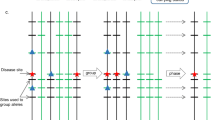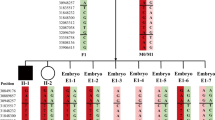Abstract
Preimplantation genetic diagnosis (PGD) has been considered as an alternative to prenatal diagnosis for prevention of genetic disorders while avoiding the subsequent termination of pregnancy. However, the limited amount of template DNA available in a single diploid cell used for PGD leads to number of problems including an increased incidence of detectable contamination; amplification failure and allele drop out. Due to their highly polymorphic and amplifiable characteristics, short tandem repeat (STR) analysis has been proposed as a mean to overcome these limitations. Heterozygosity of the applied STRs is of paramount importance in their informativity, and should therefore be studied in any certain population. Here, for the first time, we report on the heterozygosity analysis of five STR markers (D5S1408, D5S1417, D5S610, D5S629 and D5S637) flanking to SMA gene region, to examine their applicability in the PGD for SMA disease. We have also investigated other statistical features of these markers and found that all of the five studied STRs were informative and four meet the Hardy–Weinberg equilibrium for the studied population. Furthermore, our results propose that similar approaches can be used for the PGD of other single gene disorders.



Similar content being viewed by others
References
El-Hazmi MA (1999) Spectrum of genetic disorders and the impact on health care delivery: an introduction. East Mediterr Health J 5(6):1104–1113
Verlinsky Y, Kuliev A (2005) Practical preimplantation genetic diagnosis, 11th edn. Springer, London
Wells D, Delhanty JD (2001) Preimplantation genetic diagnosis: applications for molecular medicine. Trends Mol Med 7(1):23–30
Lavery SA et al (2002) Preimplantation genetic diagnosis: patients’ experiences and attitudes. Hum Reprod 17(9):2464–2467
Kuliev A, Verlinsky Y (2005) Place of preimplantation diagnosis in genetic practice. Am J Med Genet A 134A(1):105–110
Verlinsky Y, Kuliev A (2002) Preimplantation diagnosis for diseases with genetic predisposition and nondisease testing. Expert Rev Mol Diagn 2(5):509–513
Thornhill AR, Snow K (2002) Molecular diagnostics in preimplantation genetic diagnosis. J Mol Diagn 4(1):11–29
Hearne CM, Ghosh S (1992) Microsatellites for linkage analysis of genetic traits. Trends Genet 8(8):288–294
Demeter SJ et al (2010) Genetic variation at 15 polymorphic, autosomal, short tandem repeat loci of two Hungarian populations in Transylvania, Romania. Croat Med J 51(6):515–523
Shatsky MR, Nussinov (2011) Optimization of sequence alignment for simple sequence repeat regions. BMC Res Notes 4:239
Zhu BF et al (2010) Population genetic analysis of 15 autosomal STR loci in the Russian population of northeastern Inner-Mongolia, China. Mol Biol Rep 37(8):3889–3895
Hwa HL et al (2010) Fourteen non-CODIS autosomal short tandem repeat loci multiplex data from Taiwanese. Int J Legal Med 125(2):219–226
Agrawal S, Khan F (2005) Reconstructing recent human phylogenies with forensic STR loci: a statistical approach. BMC Genet 6:47
Agrawal S et al (2004) Short tandem repeat technology has diverse applications: individual identification, phylogenetic reconstruction and chimerism based post haematopoietic stem cell transplantation graft monitoring. Indian J Med Sci 58(7):297–304
Matsushita H et al (2003) Genetic analysis of 18 STR loci on the X chromosome in a Japanese population. Int Congr Ser 1239:331–333
Kee BP et al (2011) Genetic data for 15 STR loci in a Kadazan-Dusun population from East Malaysia. Genet Mol Res 10(2):739–743
Sambrook J, Fritsch EF (1989) Molecular cloning, a laboratory manual, 2nd edn. Cold Spring Harbor Laboratory Press, New York
Rozen S, Skaletsky HJ (2000) Primer3 on the www for general users and for biologist programmers. In: Krawetz S, Misener S (eds) Bioinformatics methods and protocols. Methods in molecular biology. Humana Press, Totowa
Kuulasma T (2002) Oligo explorer. University of Kuopio, Kuopio
Botstein D et al (1980) Construction of a genetic linkage map in man using restriction fragment length polymorphisms. Am J Hum Genet 32(3):314–331
Nei M (1978) Estimation of average heterozygosity and genetic distance from a small number of individuals. Genetics 89(3):583–590
Edwards A et al (1992) Genetic variation at five trimeric and tetrameric tandem repeat loci in four human population groups. Genomics 12(2):241–253
Guo SW, Thompson EA (1992) Performing the exact test of Hardy-Weinberg proportion for multiple alleles. Biometrics 48(2):361–372
Fisher RA (1951) Standard calculations for evaluating a blood-group system. Heredity 5(1):95–102
Fung WK et al (2002) Power of exclusion revisited: probability of excluding relatives of the true father from paternity. Int J Legal Med 116(2):64–67
Girardet A et al (2008) Efficient strategies for preimplantation genetic diagnosis of spinal muscular atrophy. Fertil Steril 90(2):443e7–443e12
Author information
Authors and Affiliations
Corresponding author
Rights and permissions
About this article
Cite this article
Korzebor, A., Derakhshandeh-Peykar, P., Meshkani, M. et al. Heterozygosity assessment of five STR loci located at 5q13 region for preimplantation genetic diagnosis of spinal muscular atrophy. Mol Biol Rep 40, 67–72 (2013). https://doi.org/10.1007/s11033-012-2011-3
Received:
Accepted:
Published:
Issue Date:
DOI: https://doi.org/10.1007/s11033-012-2011-3




